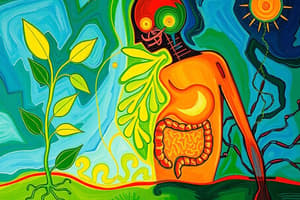Podcast
Questions and Answers
What is the primary function of chlorophyll in photosynthesis?
What is the primary function of chlorophyll in photosynthesis?
- To produce carbohydrates directly
- To absorb solar energy (correct)
- To regulate water loss in plants
- To release oxygen into the atmosphere
Which of the following processes occurs during the light reactions of photosynthesis?
Which of the following processes occurs during the light reactions of photosynthesis?
- Production of glucose
- Synthesis of ATP (correct)
- Regeneration of RuBP
- Carbon fixation
In cyclic electron flow, which Photosystem is utilized?
In cyclic electron flow, which Photosystem is utilized?
- Only Photosystem I (correct)
- Both Photosystem I and II
- Photosystem II
- Neither Photosystem I nor II
During the Calvin Cycle, which step involves the addition of CO2 to RuBP?
During the Calvin Cycle, which step involves the addition of CO2 to RuBP?
What is the end product of the Calvin Cycle after reduction?
What is the end product of the Calvin Cycle after reduction?
What is produced as a result of cyclic electron flow?
What is produced as a result of cyclic electron flow?
Which component is regenerated during the Calvin Cycle to continue the process?
Which component is regenerated during the Calvin Cycle to continue the process?
What is the primary purpose of the light reactions in photosynthesis?
What is the primary purpose of the light reactions in photosynthesis?
Which molecule is produced during the light reactions and is used in the Calvin Cycle?
Which molecule is produced during the light reactions and is used in the Calvin Cycle?
Which of the following correctly describes cyclic electron flow?
Which of the following correctly describes cyclic electron flow?
Flashcards
Photosynthesis
Photosynthesis
The process by which autotrophic organisms use sunlight to convert carbon dioxide and water into energy-rich carbohydrates.
Chlorophyll
Chlorophyll
A pigment found in chloroplasts that absorbs sunlight for photosynthesis.
Light reactions
Light reactions
The first stage of photosynthesis, where light energy is converted into chemical energy in the form of ATP and NADPH.
Calvin cycle
Calvin cycle
Signup and view all the flashcards
Cyclic electron flow
Cyclic electron flow
Signup and view all the flashcards
Carbon fixation
Carbon fixation
Signup and view all the flashcards
Reduction
Reduction
Signup and view all the flashcards
Regeneration of RuBP
Regeneration of RuBP
Signup and view all the flashcards
ATP
ATP
Signup and view all the flashcards
NADPH
NADPH
Signup and view all the flashcards
Thylakoid membranes
Thylakoid membranes
Signup and view all the flashcards
Study Notes
Photosynthesis Introduction
- Autotrophs use chlorophyll to harvest solar energy, storing it in ATP and carbohydrates.
- In eukaryotes, chlorophyll is within chloroplast thylakoid membranes.
- Photosynthesis involves three key processes:
- Light-dependent reactions (energy absorption from sunlight)
- Light-dependent reactions (reactivation of reaction center)
- Dark reactions (carbohydrates production via carbon fixation)
Photosynthesis Chemical Reaction
- 6CO₂ + 6H₂O → C₆H₁₂O₆ + 6O₂
- Carbon dioxide + Water → Glucose + Oxygen
- This is the overall chemical reaction for photosynthesis
Photosynthesis During Photosynthesis
- Energy from sunlight drives glucose synthesis from CO₂ and H₂O.
- Sunlight's energy is converted into a usable form (potential)
Stages of Photosynthesis - Light Reactions
- Use sunlight to reduce NADP+ to NADPH and split water, releasing oxygen.
- ATP is formed (phosphorylation) by the movement of hydrogen ions.
- Happen in the thylakoids of the chloroplast
Stages of Photosynthesis - Calvin Cycle
- Also called dark reactions, doesn't require direct light energy.
- CO₂ is incorporated into organic molecules (carbon fixation)
- NADPH and ATP are used to produce carbohydrates from fixed carbon.
- Occurs in the chloroplast stroma.
- ADP, inorganic phosphate, and NADP+ are returned to the light reactions
Light Reactions Events
- Light energy excites chlorophyll electrons from Photosystem II to a higher energy level.
- Electrons are passed through electron transport chains, releasing energy to pump H+ into the thylakoid space.
- H+ ions flow through ATP synthase, producing ATP.
- Electrons are passed to Photosystem I, then to NADP+ to produce NADPH.
Cyclic Electron Flow
- An alternative electron pathway, where electrons from Photosystem I return to the electron transport chain.
- This route produces ATP but not NADPH.
Calvin Cycle - Carbon Fixation
- CO₂ is incorporated into RuBP (ribulose biphosphate), a 5-carbon sugar.
- This reaction is catalyzed by RuBisCO (ribulose-1,5-bisphosphate carboxylase/oxygenase).
- RuBisCO is one of the most common proteins on Earth.
- The resulting product (6-carbon molecule) is unstable and immediately splits into 2 molecules of 3-phosphoglycerate (3-carbon molecule).
Calvin Cycle - Reduction
- A phosphate group from ATP is added to 3-phosphoglycerate, forming 1,3-biphosphoglycerate.
- NADPH reduces 1,3-biphosphoglycerate to G3P (glyceraldehyde-3-phosphate).
- G3P molecules are the building blocks for glucose (or other sugars).
Calvin Cycle - Regeneration
- Five out of six G3P molecules are used to regenerate RuBP, requiring ATP.
- The regeneration of RuBP allows the Calvin cycle to continue.
Studying That Suits You
Use AI to generate personalized quizzes and flashcards to suit your learning preferences.



